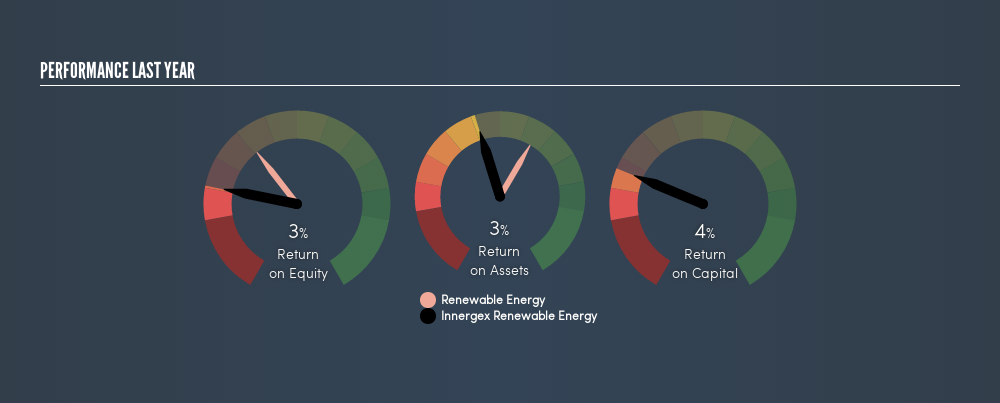- Canada
- /
- Renewable Energy
- /
- TSX:INE
Is Innergex Renewable Energy Inc.’s (TSE:INE) 3.9% Return On Capital Employed Good News?

Want to participate in a short research study? Help shape the future of investing tools and you could win a $250 gift card!
Today we are going to look at Innergex Renewable Energy Inc. (TSE:INE) to see whether it might be an attractive investment prospect. In particular, we'll consider its Return On Capital Employed (ROCE), as that can give us insight into how profitably the company is able to employ capital in its business.
First, we'll go over how we calculate ROCE. Second, we'll look at its ROCE compared to similar companies. Finally, we'll look at how its current liabilities affect its ROCE.
Return On Capital Employed (ROCE): What is it?
ROCE is a metric for evaluating how much pre-tax income (in percentage terms) a company earns on the capital invested in its business. Generally speaking a higher ROCE is better. Overall, it is a valuable metric that has its flaws. Author Edwin Whiting says to be careful when comparing the ROCE of different businesses, since 'No two businesses are exactly alike.'
So, How Do We Calculate ROCE?
The formula for calculating the return on capital employed is:
Return on Capital Employed = Earnings Before Interest and Tax (EBIT) ÷ (Total Assets - Current Liabilities)
Or for Innergex Renewable Energy:
0.039 = CA$223m ÷ (CA$6.7b - CA$994m) (Based on the trailing twelve months to March 2019.)
So, Innergex Renewable Energy has an ROCE of 3.9%.
View our latest analysis for Innergex Renewable Energy
Is Innergex Renewable Energy's ROCE Good?
ROCE can be useful when making comparisons, such as between similar companies. Using our data, Innergex Renewable Energy's ROCE appears to be around the 4.0% average of the Renewable Energy industry. Independently of how Innergex Renewable Energy compares to its industry, its ROCE in absolute terms is low; especially compared to the ~1.9% available in government bonds. Readers may wish to look for more rewarding investments.

It is important to remember that ROCE shows past performance, and is not necessarily predictive. Companies in cyclical industries can be difficult to understand using ROCE, as returns typically look high during boom times, and low during busts. ROCE is only a point-in-time measure. Since the future is so important for investors, you should check out our free report on analyst forecasts for Innergex Renewable Energy.
What Are Current Liabilities, And How Do They Affect Innergex Renewable Energy's ROCE?
Current liabilities include invoices, such as supplier payments, short-term debt, or a tax bill, that need to be paid within 12 months. The ROCE equation subtracts current liabilities from capital employed, so a company with a lot of current liabilities appears to have less capital employed, and a higher ROCE than otherwise. To counteract this, we check if a company has high current liabilities, relative to its total assets.
Innergex Renewable Energy has total assets of CA$6.7b and current liabilities of CA$994m. As a result, its current liabilities are equal to approximately 15% of its total assets. This is not a high level of current liabilities, which would not boost the ROCE by much.
The Bottom Line On Innergex Renewable Energy's ROCE
Innergex Renewable Energy has a poor ROCE, and there may be better investment prospects out there. Of course, you might find a fantastic investment by looking at a few good candidates. So take a peek at this free list of companies with modest (or no) debt, trading on a P/E below 20.
If you like to buy stocks alongside management, then you might just love this free list of companies. (Hint: insiders have been buying them).
We aim to bring you long-term focused research analysis driven by fundamental data. Note that our analysis may not factor in the latest price-sensitive company announcements or qualitative material.
If you spot an error that warrants correction, please contact the editor at editorial-team@simplywallst.com. This article by Simply Wall St is general in nature. It does not constitute a recommendation to buy or sell any stock, and does not take account of your objectives, or your financial situation. Simply Wall St has no position in the stocks mentioned. Thank you for reading.
About TSX:INE
Innergex Renewable Energy
Operates as an independent renewable power producer in Canada, the United States, France, and Chile.
Low with questionable track record.
Similar Companies
Market Insights
Community Narratives





